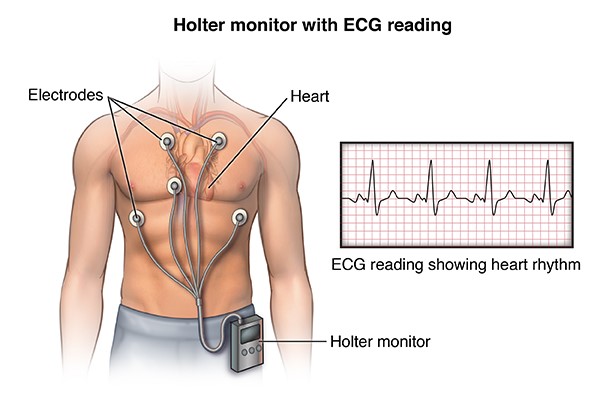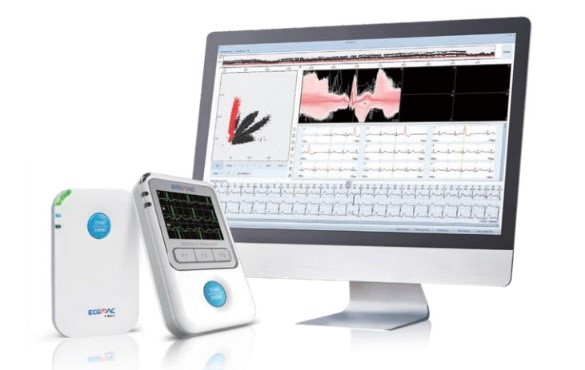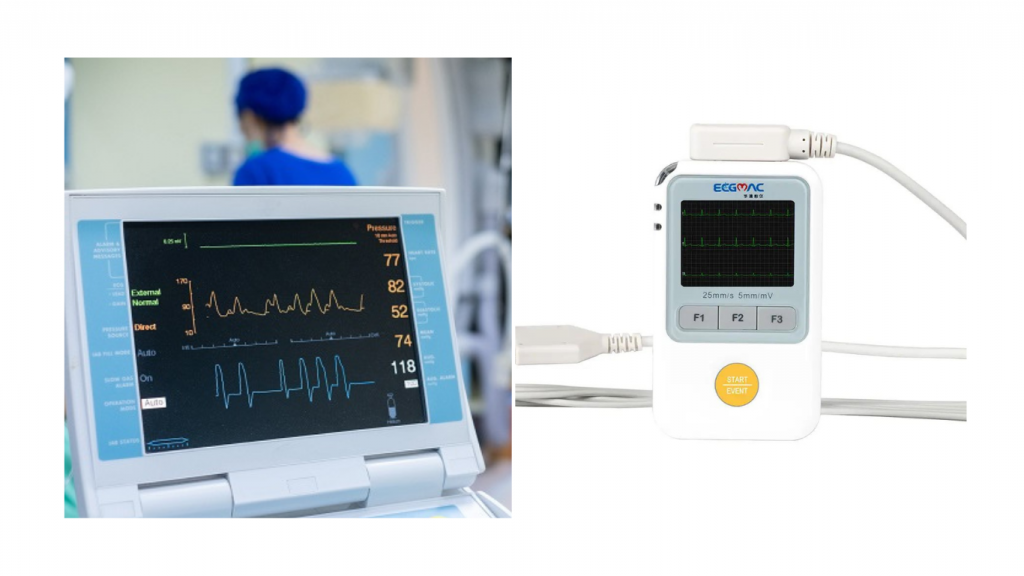Holter monitor and electrocardiogram machines (also called ECG or EKG) are two common heart rate monitoring tools used today to assist doctors in diagnosing cardiac issues in patients through recording data on heart rate, stability or instability of the heartbeat, etc. In this comparison, we will delve into the distinctive features of each device, shedding light on how they complement each other in diagnosing and understanding various cardiac conditions. By understanding the strengths and limitations of both the Holter monitor and the ECG machine, healthcare professionals can make informed decisions to provide the best care for their patient’s cardiovascular health.
What is an electrocardiogram?
An electrocardiogram machine is a medical device used to record the electrical activity of the heart. An ECG machine is a non-invasive and painless technique, commonly used to evaluate the heart’s activity, detect cardiac issues, and assist in diagnosing heart diseases.
The operating principle of an ECG machine is based on recording the electrical signals from the patient’s heart through electrodes attached to the chest, limbs, and neck. When the heart contracts and relaxes to pump blood, it generates electrical waveforms. These electrical waveforms are collected by the ECG machine, and the resulting graph is displayed on paper or an electronic screen.

An electrocardiogram machine
What is a Holter monitor?
Holter monitor is a method of continuously monitoring and recording the heart’s electrical activity over an extended period, typically 24 to 48 hours or even longer. It is used to detect and record variations in the heart’s electrical activity throughout the day, including during the user’s daily activities, sleep time, and periods of rest.

Holter monitor
The Holter monitor takes the form of a compact recording device that continuously captures the heart’s electrical signals from electrodes attached to the skin (placed on the chest and abdomen) during the monitoring period. Usually, the recording device has a button for the patient to press to mark the times when symptoms occur. After the monitoring period is complete, the data is extracted and analyzed by healthcare experts to identify anomalies and diagnose long-term or irregular cardiac issues.
In general, the Holter monitor is a portable type of ECG machine that can be worn in various human activity conditions to provide comprehensive information about the heart’s electrical activity over an extended period.


Holter monitor model H12B-plus Holter monitor model Digitrak XT
The difference between ECG machines and Holter monitor
ECG machines and Holter monitors are two essential tools in assessing cardiac activity. To provide an overview, we will compare these devices in some fundamental aspects such as their purposes, size, monitoring duration, applications,…
| ECG Machines | Holter Monitor | |
| Purpose | ECG machines are commonly used to identify short-term or acute cardiac electrical issues. | On the other hand, the Holter monitor is utilized to detect long-term, infrequent, or concealed cardiac electrical problems |
| Size | ECG machines typically weigh around 2-3 kg and have about 10 measuring electrodes. | The Holter monitor recording device is more compact, weighing approximately 60-80g, and connects to 5 to 10 electrodes depending on the purpose and manufacturer. |
| Ambulatory nature | ECG machines are usually fixed in position at healthcare facilities, and specific measurement requirements need to be followed during the recording process. | In contrast, the Holter monitor performs mobile monitoring on the wearer, capturing and recording the heart’s electrical activity throughout their daily activities. |
| Duration of monitoring | ECG machines only record the heart’s electrical activity for a very short period, typically from 10 seconds to 1 minute. | On the other hand, the Holter monitor records the heart’s electrical activity over an extended period, usually ranging from 24 to 48 hours or even longer, depending on the doctor’s recommendation. |
| Applications | Regular ECG machines only capture a limited number of cardiac cycles. | The Holter monitor, a mobile monitoring device, provides more comprehensive information about the heart’s electrical activity throughout the day. |
| Results | The result from a regular ECG machine is a short and limited recording, showing the heart’s electrical activity during a brief period. | In contrast, the Holter monitor typically produces a lengthy schematic report with extensive information about the heart’s electrical activity during the monitoring period and analyzed data. |
| Applications | ECG machines are commonly used in emergency cases that require quick or follow-up examinations during regular health check-ups. | The Holter monitor is usually employed for monitoring and diagnosing challenging, long-term, or infrequent cardiac electrical issues that are difficult to detect. |
In summary, the Holter monitor is a method for monitoring cardiac activity over an extended period, suitable for assessing unstable cardiac electrical conditions. On the other hand, a regular ECG machine records the heart’s electrical activity for a short period and is typically used in specific situations or when the patient exhibits clinical symptoms. Despite the limitation in monitoring duration, the ECG machine provides quick results and is a useful tool in identifying short-term arrhythmias and notable cardiac conditions.
When both the Holter monitor and regular ECG machine are used together, doctors can have a comprehensive and detailed understanding of the patient’s cardiac activity. The combination of these two tools facilitates accurate diagnosis and appropriate treatment planning, leading to improved management and care of the patient’s cardiovascular health.
The advantage of the Holter monitor
The Holter monitor offers several significant advantages in monitoring and diagnosing cardiac electrical activity. Below are some key advantages of this method:
- Continuous monitoring: The Holter monitor provides continuous and prolonged monitoring of cardiac electrical activity, typically for 24 to 48 hours or even longer. This allows for the diagnosis of long-term or infrequent cardiac issues that may not be captured in the brief recordings of a regular ECG machine.
- Detection of short-term events: The Holter monitor can detect and record short-term variations in cardiac electrical activity, such as arrhythmias and other abnormal electrical events during the monitoring period.
- Real-time activity assessment: The Holter monitor offers a comprehensive view of the heart’s electrical activity during daily activities, including periods of exertion, physical activity, sleep, and rest. It also records the occurrences of symptoms experienced by the patient.
- Diagnosis and treatment monitoring: The Holter monitor is a valuable tool for diagnosing cardiac issues and assessing the effectiveness of prescribed treatments. It helps healthcare experts monitor and adjust treatment protocols to improve the patient’s health.
In conclusion, the Holter monitor has many important advantages in monitoring and diagnosing cardiac electrical activity, providing detailed and continuous information to support the diagnosis and treatment of cardiac disorders.
Indications
- Experiencing symptoms related to arrhythmias such as fainting, shortness of breath, chest pain, or recurrent dizziness.
- Suspecting neurological events (TIA, strokes) caused by atrial or ventricular fibrillation.
- Suspecting malfunction of implanted cardiac devices like pacemakers, ICDs (Implantable Cardioverter Defibrillator), etc.
- Exhibiting abnormal signs during a regular ECG but lacking sufficient information for a conclusive diagnosis.
- Evaluating the effectiveness of prescribed treatment protocols.


